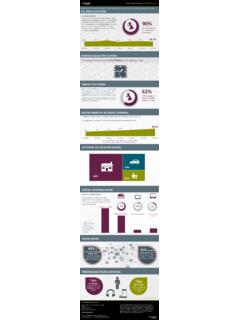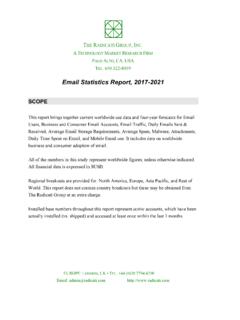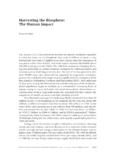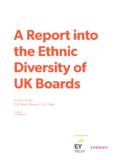Transcription of School Workforce in England: November 2016
1 Contact: Email: Press office: 020 7783 8300 Public enquiries: 0370 000 2288 School Workforce in England: November 2016 SFR 25/2017, 22 June 2017 The total number of full-time equivalent (FTE) teachers working in state-funded schools in England has continued to rise. In November 2016 there thousand FTE teachers. Between 2015 and 2016 the total number of FTE teachers increased by thousand ( per cent) from thousand FTEs to thousand FTEs. The FTE number of teachers in all nursery/primary schools has risen by thousand ( per cent) over the last year. The FTE number of teachers in all secondary schools has reduced by thousand (down by per cent). Changes in teacher numbers over time mainly reflect changes in pupil numbers. Between 2011 and 2016, the rate of entry into teaching has remained higher than the percentage of qualified teachers leaving the profession.
2 The total number of FTE qualified entrants to teaching has decreased from 45,120 ( per cent) in 2015 to 43,830 ( per cent) in 2016. Over the same period the total number of FTE qualified teachers leaving teaching has also decreased from 43,370 ( per cent) in 2015 to 42,830 ( per cent). Contact: Email: Press office: 020 7783 8300 Public enquiries: 0370 000 2288 Contents The size of the schools Workforce (SFR Tables 1, 2a, and 2b) .. 4 Key changes between 2014 and 5 Teacher flows (SFR Tables 7a, 7b and 8) .. 6 Deployment and characteristics of teachers and other schools staff (SFR Tables 3, 4, 5 and 6) .. 7 Teachers with and without Qualified Teacher Status .. 7 Gender of School staff .. 7 Disabled School teachers .. 8 Age of School teachers .. 8 Ethnicity of School staff.
3 9 Full and part-time working amongst School staff .. 9 Teachers pay (SFR Tables 9a, 9b, 9c and 9d) .. 10 Teachers qualifications and curriculum taught (SFR Tables 10, 11, 12 and 13) .. 10 Teacher vacancies (SFR Tables 14 and 15) .. 10 Teacher sickness absence (SFR Table 16) .. 11 Pupil teacher ratios (SFR Tables 17a and 17b) .. 11 Teacher retirements and out of service teachers (SFR Tables 18 23) .. 12 Accompanying tables .. 13 Further information is available .. 14 National Statistics .. 15 Technical information .. 16 Get in touch .. 16 Media enquiries .. 16 Other enquiries/feedback .. 16 Contact: Email: Press office: 020 7783 8300 Public enquiries: 0370 000 2288 About this release This statistical first release provides the latest information on the composition of the School Workforce employed in local authority maintained nursery, primary, secondary and special schools and all primary, secondary, and special academy schools and free schools in England.
4 The release is based on data collected from schools and local authorities in November 2016 as part of the seventh annual School Workforce Census. Data on independent schools, sixth form colleges and further education establishments are not included. The census collects detailed information on teachers, teaching assistants and other non-classroom based School support staff. The SFR includes statistics showing the time series of School staff numbers by grade/role and by School phase. It also provides detailed characteristics data on School staff their age, gender, ethnicity and whether they work full or part-time. The SFR also includes statistics on teachers salaries, qualifications and sickness absence levels. In addition, for a sample of secondary School teachers, statistics are published on the curriculum subject taught, whether teachers have qualifications in the subjects they teach and the hours spent teaching by subject.
5 In addition, the SFR includes statistics on the number of teaching vacancies (and by subject for secondary schools) and the number of teaching posts that are filled on a temporary basis. The quality of data in this release depends on schools correctly completing their returns. Each year we review the process to consider what additional validation checks we can build into the collection process to help schools, and how we can supplement the data schools return with other data we hold to improve the data quality. In this publication This statistical release contains time series statistics on the number of teachers, teaching assistants and support staff employed by state-funded schools and local authorities in England. It also provides details on teacher and support staff characteristics and deployment, teacher flows, teacher pay, teacher sickness absence, teacher qualifications and curriculum taught, as well as teaching vacancies and pupil teacher ratios.
6 These tables are contained in (Excel .xls) In addition, there are statistics on teacher retirements and out of service teachers in (Excel .xls) and School level statistics (with LA and Region summaries) in the underlying data (open format .csv and metadata .txt) The accompanying quality and methodology information document, provides information on the data sources, their coverage and quality and explains the methodology used in producing the data. Feedback We are changing how our statistical releases look and welcome feedback on any aspect of this document at 4 The size of the schools Workforce (SFR Tables 1, 2a, and 2b) The following tables show how the size of the Workforce in schools has changed since 2010 when the School Workforce Census was first introduced.
7 In November 2016 there were million people (headcount) working in state-funded schools in England. This comprises thousand teachers, thousand occasional teachers (on contracts of less than one month), thousand teaching assistants, thousand School support staff and thousand additional third party support staff. There were 140 schools ( of all open schools) in the November 2016 census that did not supply usable data and estimates for these schools have been included in the following figures. Further information on the estimation for missing schools is contained within the accompanying quality and methodology information document. Table 1: Composition of the schools Workforce (headcount): England, 2010 - 2016, thousands Teachers Occasional Teachers Teaching Assistants School Support staff Third Party Support staff Total Headcount 2010 - 1, 2011 1, 2012 1, 2013 1, 2014 1, 2015 1, 2016 1, Source: School Workforce Census 2010 - 2016 The majority of teachers work full-time and the majority of other School staff work part-time therefore headline figures are usually presented in terms of the number of full-time equivalent (FTE) staff members.
8 FTE figures are not available for occasional teachers or agency/third-party support staff and FTE figures for School support staff were not available for 2010. In November 2016 there were thousand full-time equivalent (FTE) School Workforce employees (classroom and leadership group teachers, teaching assistants, School support staff and auxiliary staff) working in state-funded schools in England. In FTE terms, 48 per cent of the schools Workforce are teachers, 28 per cent are teaching assistants and 25 per cent are non-classroom based support staff. Table 2: Composition of the schools Workforce (full-time equivalent): England, 2011-2016, thousands Teachers Teaching Assistants School Support staff Total Full-time equivalents 2011 2012 2013 2014 2015 2016 Source: School Workforce Census 2011 - 2016 The latest statistics continue the trend of previous years where the size of the School Workforce is increasing due to increases in the number of teachers, teaching assistants and School support staff.
9 The increase in total teacher numbers is focussed in the nursery/primary sector. The nursery & primary School population has been rising since 2009 and reached million children in 2016. Based on 2016 s pupil projections the rate of increase is forecast to slow and the population is projected to stabilise in 2020 at 5 million children. The secondary School population rose to million in 2016 (the first rise since 2005) as the increased births from 2002 reached secondary School age. The secondary School population is projected to continue increasing to million by 2020 and further until 2025 when it is expected to peak at million. This information is taken from the latest published pupil projections data (see here). The pupil projections will be updated on 13 July 2017.
10 Key changes between 2015 and 2016 Between 2015 and 2016 there has been little change in the total number of staff working in schools; from thousand FTE staff in 2015 to thousand FTE staff in 2016. Within this overall static picture, there has been a rise in the number of primary School staff and a small decrease in the number of staff working in the secondary School phase. Overall teacher numbers have increased further, by per cent, between 2015 and 2016. The total number of FTE teachers increased by thousand; from thousand FTEs in 2015 to thousand FTEs in 2016. Within the nursery/primary phase, the total number of FTE teachers increased by thousand; from thousand FTEs in 2015 to thousand FTE teachers. This represents a per cent increase.














